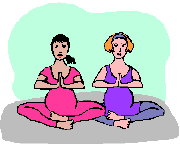Pregnancy & Fitness
 The following article is a small excerpt from one of my books. I hope you’ll want to learn more and let me help you to get into the best shape of your life.
The following article is a small excerpt from one of my books. I hope you’ll want to learn more and let me help you to get into the best shape of your life.
If you are pregnant and wish to begin a fitness routine you should first consult with your doctor and tell him what you plan to do. Once he approves of your plan, you should consult with a certified personal trainer who specializes and understands prenatal exercise and can design a program that is fit for your needs. You should try to exercise about 3 times a week for between 20 and 30 minutes and listen to your body. If you feel faint, dizzy, headaches, blurred vision, nausea, chest pain, vaginal bleeding or abdominal pain, you should stop exercising and consult your doctor.
Providing all is well you should try to exercise between 50 and 80 percent of your maximum target rate when training. To calculate your maximum heart rate simply subtract your age from 220. This figure is your maximum heart rate and depending on your fitness level you can then calculate where your heart rate should be during exercise to gain the maximum benefit.
During pregnancy a woman’s body goes through many changes and because of these changes you will have to adapt your workout and modify your program to address some of these changes. These changes include a resting heartbeat of about 10 to 15 beats per minute higher than normal. You can use the formula in the book ‘Get Fit Stay Fit’to more accurately figure out your maximum heart rate. Your blood flow to your muscles decreases therefore your aerobic capacity decreases and as you move along in your term your aerobic capacity diminishes further, and as you become bigger your centre of gravity changes. With all these changes going on, you should prepare yourself to go slower in your workouts.
You may also experience a change in your eating habits as physical changes begin to affect your appetite. Early in your pregnancy, morning sickness due to a certain hormone may make it impossible for you to eat anything but crackers. You may also want to adjust your workouts to the afternoon if you are sick in the mornings, and eat smaller meals throughout the day. Taking a prenatal vitamin supplement may be recommended by your doctor to ensure you are getting all the appropriate nutrition for you and your baby but remember supplements do not take the place of a good balanced diet.
If you train outdoors by running or cycling you may want to consider moving indoors. By training inside you can avoid the outdoor hazards like potholes, uneven ground and cars that if you fall could hurt you and your baby. You are also able to better control your body temperature, hydration and the level to which you train.
Becoming pregnant is also not the time to start a new rigorous training regiment. If you are a beginner you should take it easy and listen to the health care professional who is advising you. If you are already an athlete of some degree here are some tips to watch out for.
- Avoid all contact sports
- Avoid scuba diving because it can decrease the pressure in your uterus
- Avoid training in high altitudes which can deprive your fetus of necessary oxygen
- Avoid exercising outdoors especially on hot or cold days
Exercise during your pregnancy can give you many benefits. It can ease or prevent any back pain you may experience, it can help increase your energy level, prepare you for the demands of giving birth and help you on your way to get back into shape after you have given birth.
If you are performing regular exercise and miss one of your periods, but don’t suspect you are pregnant you may be experiencing amenorrhea. Do not ignore this. Consult with your doctor. Prolonged amenorrhea can interfere with your health, by making you three times more prone to stress fractures, premature osteoporosis, possibly a higher risk of heart disease and you may not be able to conceive easily in the future when you want to. Health care professionals have different thoughts to treating amenorrhea. Some have a wait and see attitude and that your body will adapt to the extra stresses of working out and eating a lower calorie diet and will reverse itself. Others feel you should change your diet by gaining a minimum of 5 pounds and limit the amount you exercise. This will hopefully get your system back on track.
I know you want to get in shape and look great. Whatever your fitness goal…to slim down…gain muscle…tone your arms or flatten your tummy…I’m here to help you accomplish your goals and to improve your fitness level. If you have enjoyed this article and the many other free features on my site, and would like some more comprehensive information such as fitness books and CD’s to aid you in achieving your health and fitness goals, please visit my ONLINE STORE where you will find innovative natural health and beauty products to help you become the BEST YOU CAN BE !


 The following article is a small excerpt from one of my books. I hope you’ll want to learn more and let me help you to get into the best shape of your life.
The following article is a small excerpt from one of my books. I hope you’ll want to learn more and let me help you to get into the best shape of your life. The following article is a small excerpt from one of my books. I hope you’ll want to learn more and let me help you to get into the best shape of your life.
The following article is a small excerpt from one of my books. I hope you’ll want to learn more and let me help you to get into the best shape of your life.